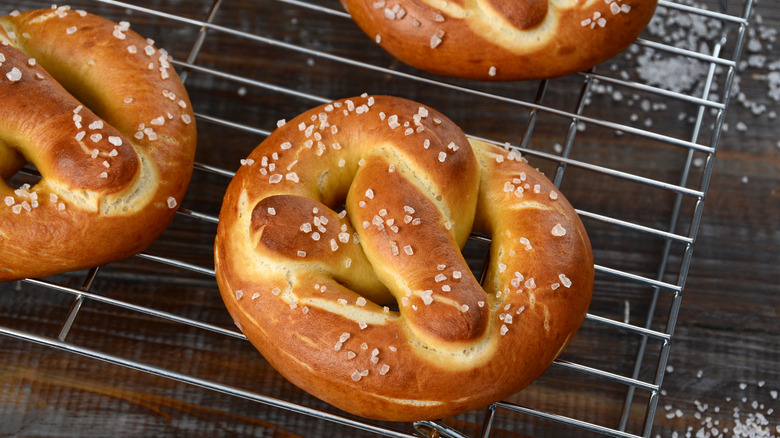Why Does Pretzel Salt Look So Different From Other Varieties?
Whether it's hard and crunchy or chewy, soft, and served with mustard, a pretzel is delicious hot or cold. But no matter what kind of pretzel you enjoy, you're almost always eating it with a heaping helping of salt. Unlike the reason why a pretzel has its trademark shape, no specific reason can be cited as to why people put salt on pretzels. People mainly put salt on their pretzels because it adds a nice crunchy texture and gives the otherwise plain dough some flavor, though some folks prefer pretzels without salt.
It all begs another question: for something optional to a pretzel, why does it need a special kind of salt? You may have noticed that the salt commonly used on most pretzels is rough and coarse, forming white "pebbles" that dot all over the knots and bends of the dough. It tastes exactly like your average, everyday salt, sure, but, what's up with pretzels requiring rough salt? The answer is that, although you can't see it, the shape of pretzel salt makes it so perfect for topping that knotted dough.
Pretzel salt's shape is flatter than regular salt
If you were told to compare a grain of salt and some salt from a pretzel, you probably couldn't tell much of a difference apart from their sizes. But the truth is that, if you were to look very, very closely at the two grains of salt, you'd notice that each of them is shaped differently.
According to Uncle Henry's Bakery, pretzel salt isn't just used because it gives the dough flavor and texture, but also because its shape allows for even distribution. Further, pretzel salt isn't merely larger than regular salt, it also features a flatter, rectangular shape. Pretzel salt works best because it's uniform, filtered, and compressed, and gives a pretzel the texture most people expect from it. That's why you usually see pretzel salt on other baked goods, like bread or desserts, mainly for texture purposes.
Though different in shape and size, pretzel salt and regular salt taste the same. This is very good because, in the likely event you don't happen to have pretzel salt on hand, the regular salt on your table or in your cupboard will have to do.
Any kind of salt you have works well for pretzels
Although pretzel salt has the perfect shape and texture for anyone making pretzels, you need not go running all over or put in a special order to get your hands on a bag of it. If you've got some fancy sea salt you've wanted to use, you're more than welcome to use it. If, as noted, you only have regular table salt at home, that will perfectly meet your needs. It's even better if you have your own salt grinder, which means you can choose how fine or coarse you wish your salt to be.
Don't want to use salt? Consider experimenting with different toppings. You might focus on making a sweet pretzel by covering it in a mixture of brown sugar and cinnamon. You could dust the pretzel in your choice of grated cheese and herbs for something more savory. You can even brush the pretzel down in melted butter and serve it with a dipping sauce like mustard, melted cheese, or chocolate. A pretzel will still be as good even if you don't have salt to top it with.


